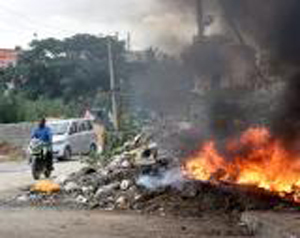1000 toxicity for a minute’s exposure to burning garbage fumes in Bengaluru
Mangalore Today News Network
New Delhi, Oct 28, 2016, DHNS: Spending a minute next to a burning garbage dump will expose a Bengalurean to 1,000 times more toxins than the daily safe limit, an Indo-US team of researchers has found.
 The team analysed 24 garbage dumps in and around the famed garden city.
The team analysed 24 garbage dumps in and around the famed garden city.
“As you walk down the street in India, there are just piles of trash growing larger and larger until somebody decides to take a match to it,” said Heidi Vreeland, a doctoral student of Duke University, USA and lead author of the study. “Even in large cities such as Bengaluru, and even in more affluent neighbourhoods, this is the norm.”
Researchers from four US institutions, Indian Institute of Technology, Kanpur and National Institute for Environmental Studies in Japan collected emission samples from 24 garbage burning sites in Bengaluru and Hoskote for the study. While the results showed high concentrations of particles near the fires, one aspect of the experiment was eye-popping. Thanks to various organic compounds burning in each fire, the test filters turned into different colours, making a rainbow of toxins.
“When you take samples of ambient air either here in the United States or in (many parts of) India, you just get different shades of grey. But these smouldering fires turned our filters into such different colours that one of my lab-mates actually thought I was looking at a panel of eye shadows,” said Vreeland.
The wide variability found in the fumes most likely stem from the trash piles containing many different organic and plastic materials. It is also a result of smouldering, incomplete combustion, which offers at least one insight into how the practice might be improved.
“From our tests, we found that somebody standing near one of these fires is getting a dose of toxins 1,000 times greater than they would from ambient air. To put it another way, a person would only need to breathe these particles for a minute to get an entire day’s worth of hazardous particulate matter,” said Michael Bergin, professor at Duke, who led the team. “Roadside trash burning is largely un-examined as a factor that influences air quality, radiative forcing, and human health even though it is ubiquitously practised throughout India. Our results indicate that near trash-burning sources, exposure to toxic particulate matter can be extremely high,” the researchers reported in the journal Atmospheric Environment.
Every year, India generates about 62 million tonnes of municipal solid waste, out of which 5.6 million tonnes are plastic waste, 0.17 million tonnes biomedical waste, 7.90 million tonnes hazardous waste and 15 lakh tonnes e-waste. The waste generation is estimated to rise from 62 million tonnes to about 165 million tonnes by 2030. However, many municipal bodies, including Bruhat Bengaluru Mahanagara Palike, were rapped by the Comptroller and Auditor General in the past for their failure to scientifically dispose off waste.
- Belthangady: Banjarumale records 100% voter turnout in Lok Sabha polls
- Dakshina Kannada, Udupi sees voter turnout of nearly 72%
- Mangaluru International Airport initiates work on precision approach lighting system
- Sandalwood star Rakshit Shetty casts his vote in Udupi, Watch
- Brisk polling across Dakshina Kannada constituency
- Ashta Mutt pontiffs cast vote in Udupi
- Udupi: Candidates Jayaprakash Hegde, Kota Srinivas Poojary exercise franchise
- Vittal: EVM technical glitch delays voting at Karopady booth
- Orange alert: Karnataka State Disaster Management cell gives animated advisory
- Lok Sabha elections 2024: Voting underway in 14 constituencies in Karnataka
- Mangaluru: Activists clash with media, police at Capitanio
- Karnataka Lok Sabha election: Voting timings, Key candidates and phase 2 polling constituencies
- Sullia: Rider dies in bike-jeep collision
- Case Against BJP Leader CT Ravi Over Social Media Post: Karnataka Poll Body
- Lok Sabha polls-24: 63% voter turnout recorded in phase 2
- LS elections 2024: Left rattled by allegations of CPI(M) veteran’s plans to join BJP
- Tejasvi Surya booked for ’seeking votes in the name of religion’ on polling day
- ‘He will shed tears’: Rahul Gandhi’s sharp attack on PM Narendra Modi
- Lok Sabha elections: 4 men collapse and die amid Phase 2 voting in Kerala
- BJP becomes first Indian party to cross Rs 100 crore ad spend on Google
- 78 year old woman, on oxygen support, casts vote in Bengaluru
- Long queues outside Bengaluru hotel for free Benne Dosa, Ghee Laddu on polling day, Watch
- What happens if NOTA gets maximum votes? Supreme Court notice to poll body
- BJP candidate K Sudhakar booked for ’Bribery’ in Karnataka, Rs 4.8 Cr cash seized
- 2 Terrorists dead, 2 army personnel injured as gunbattle resumes in J&K’s Baramulla
- New residential complex for the judges inaugurated in Mangaluru
- Absconding accused nabbed after 8 years
- Truck with cylinders turns turtle in Beltangady
- Bhoota Kola artist dies of cardiac arrest
- Development of the country should be our goal: Ganesh Karnik
- Container truck gets stuck under Modankap railway bridge
- Truck crushes bike’s pillion rider near BC Road
- Head constable dies of heart attack
- Udupi: PDO dismissed over financial irregularities
- CREDAI to resume Skill Development Program for Construction Workers in Mangaluru
- John B Monteiro elected president of Rachana Catholic Chamber of Commerce & Industry
- Sudhanshu Rai elected district president of All College Student Association
- Chief Minister to visit Mangaluru, Udupi on August 1
- Nitte University awards PhD degree to Tina Sheetal D’Souza
- Sachitha Nandagopal honoured by CMTAI for Community Service
- CITY INFORMATION
- TRAVEL
- TOURIST INFORMATION
- HEALTH CARE
- MISCELLANEOUS




 Write Comment
Write Comment E-Mail To a Friend
E-Mail To a Friend Facebook
Facebook Twitter
Twitter  Print
Print 

